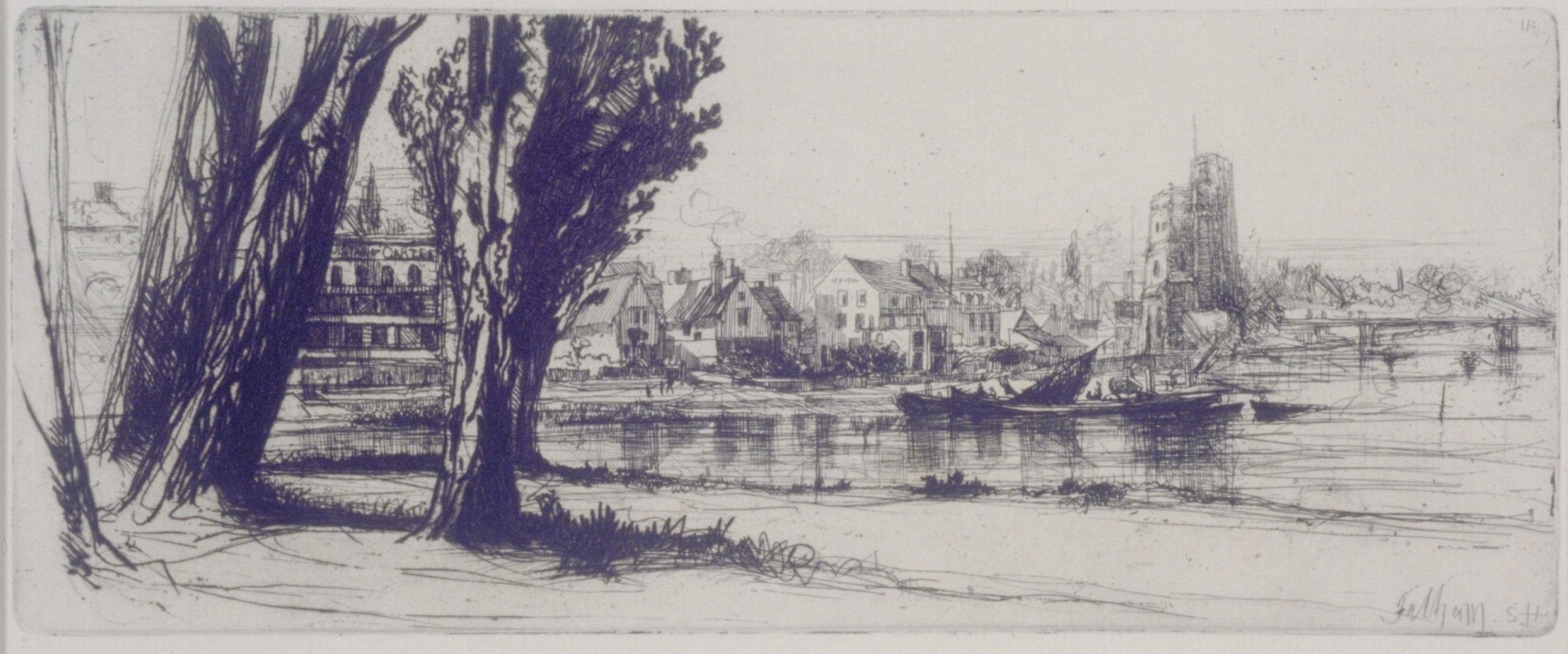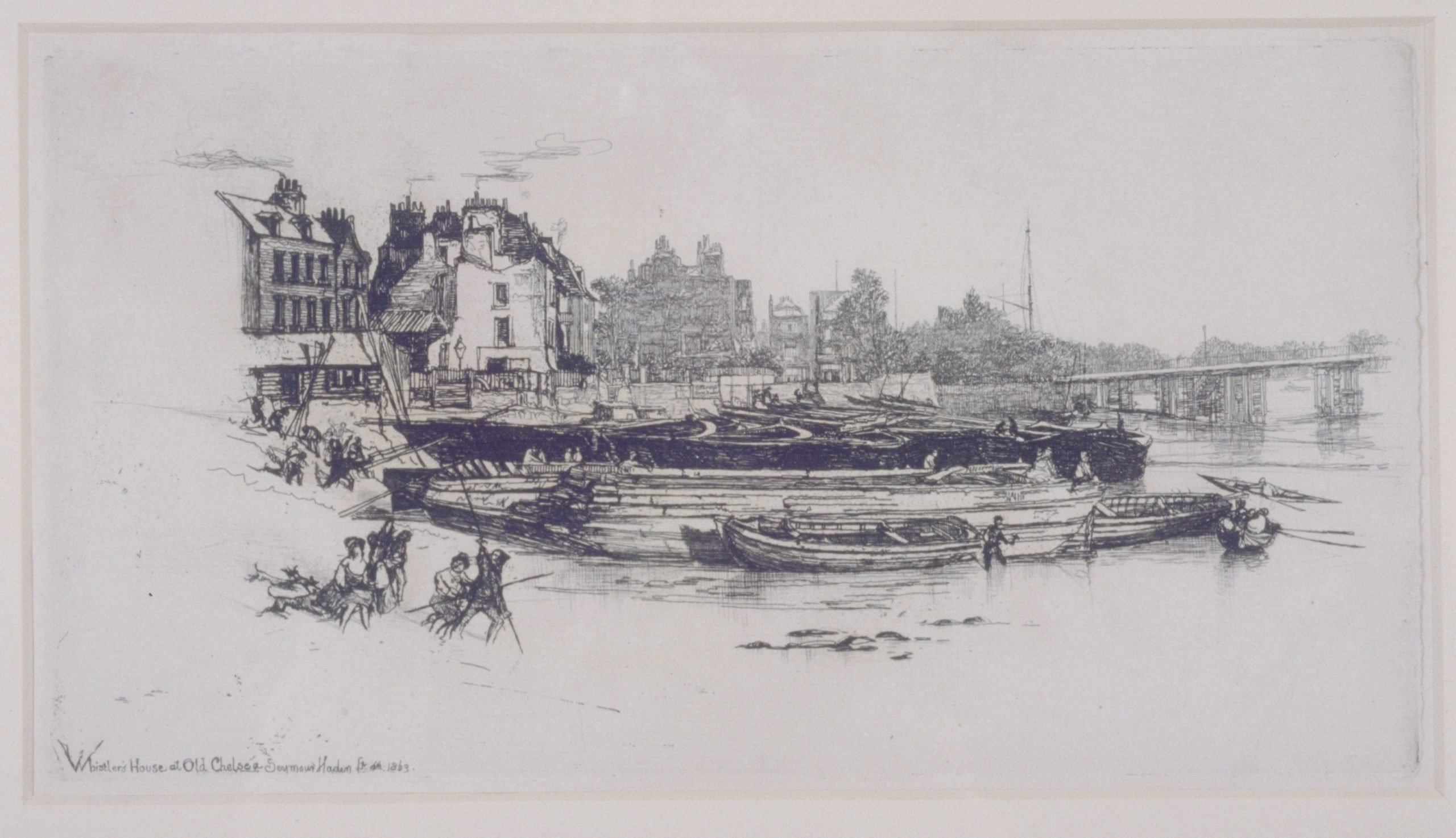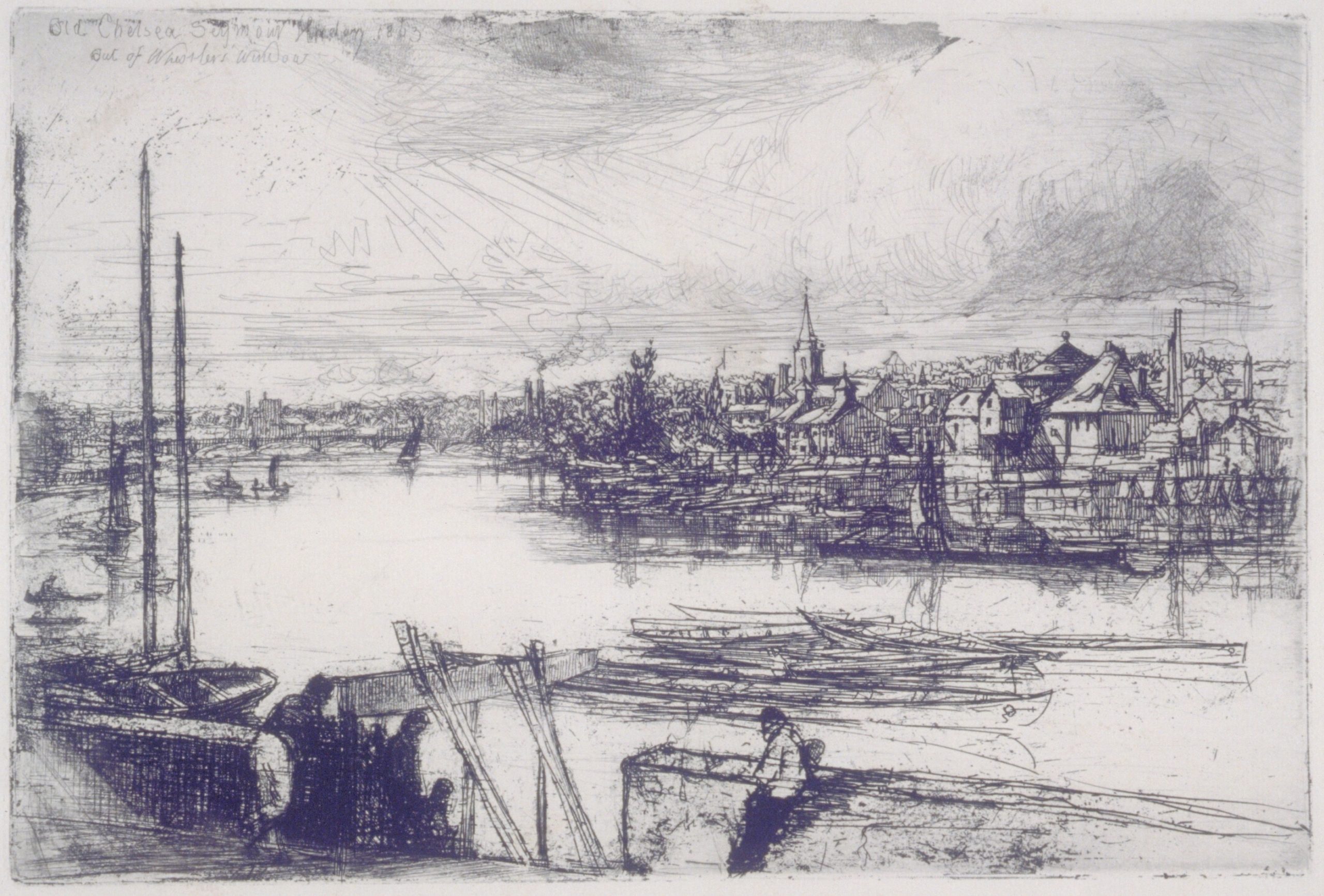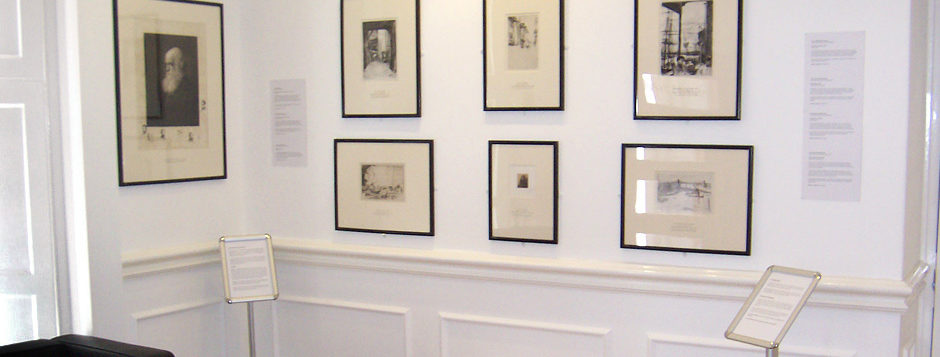Sir Frances Seymour Haden’s Études à L’eau Forte (Etching Studies), an influential portfolio of prints, was produced during the etching revival, a period marking the resurging interest in etchings during the 19th century.
A professional surgeon and amateur printmaker, Haden was an active member of the Old Etching Club from 1860-1878 and a founder of the Royal Society of Painter-Etchers (1880) in London and the Société des Aquafortistes (1862) in Paris.
Haden began creating prints during his Wunderjahr in Italy (1844); however it was only twenty years later, following French critic Phillipe Burty’s publication of ‘L’Oeuvre de M. Francis Seymour-Haden’ in the 17th volume of Gazette des Beaux-Artes (1864), that Haden began to make a name for himself as an artist in London.
Burty’s attraction to Haden was tied to his own interest in supporting the revival of printmaking as an art form: he appreciated Haden’s innovative etching style and naturalistic technique and his article on Haden spurred the amateur artist to publish the Études, which consisted of thirty etchings created between the years of 1859 and 1865. The portfolio followed the tradition of other prolific printmakers’ publications, such as Charles-François Daubigny’s Cahiers d’eaux fortes (1851) and Charles Meryon’s Eaux-fortes sur Paris (1852-1854). Published by Auguste Delâtre in Paris and London (1865-66), only 180 of Haden’s Études intended 250 editions were printed as some of the plates began to fail.
The portfolio features a reprint of Burty’s original essay for the Gazette, with five etchings interspersed throughout the text. Following this introductory piece are twenty-five pages of printed etchings and their titles. The impressions are pasted on thick wove paper and reflect one of six kinds of techniques: etching, etching with drypoint, etching and drypoint, etching with foul-biting, etching with mezzotint, and etching with/and drypoint on copper.[1]
Haden and Modern Art
Burty’s preface addresses Haden’s originality, and also includes the artist’s comments on his Études and etching style.[2] Haden has previously described in printmaking process in 1864:
Having lightly varnished the copper plate I begin by drawing with large strokes with a blunt needle and finish the same day with the finest needle, I have always noticed that those of my works which have not been begun and completed the same day are worth nothing…. As with the drawing, the biting must be rapid and vigorous and done if not at the actual spot, at least before the impression which created the drawing is lost.[3]
Haden’s statement emphasizes his engagement with the practice of plein-air (outdoor) etching. Like the later Impressionist painters, whose brushwork was sketch like and works lacked finish (fine detail), Haden’s etchings featured loose strokes and appeared fresh.[4] Often labeled as a “precursor of Impressionism,” Haden was more interested in capturing the fleeting qualities of nature in a spontaneous and convincing way than in creating a highly detailed image.[5]
While Haden’s works succeed in highlighting the effortless essence of nature, it is important to note that his insistence on solely working on-site may have been exaggerated. For example, in reference to his Études Haden claimed:
…these etchings were made without any view to publication…they were begun and finished in the open air… they have received few of the corrections and none of the additions of the studio.[6]
However, scholars concur that only two of his thirty etchings could have possibly been realized in such a way.[7] Many of his works underwent multiple state changes and some relied on the use of preliminary drawings and photographs.[8]
The Études: subject matter
Haden’s interest in establishing a clear connection between his works and nature is further evident through the Études’ subject matter. Twenty eight of the thirty etchings depict landscapes, often with few figures. Most scenes are of neighbourhoods in London, or the Welsh or Irish countryside.
In his preliminary text, Burty notes Haden’s fascination with illustrating the effortless aspects of nature, which the British critic Francis Palgrave summarizes: “Mr. Haden’s landscape-etching, we learn, has been the employment of a physician’s holiday; the rare and highly prized delight of laboriously earned leisure.”[9]
Haden makes use of feathery trees, twisting roads, and fluid streams to convey a sense of tranquility. His Early Morning in Richmond Park (No. 10 in Études à L’eau Forte) and A Sunset in Tipperary (No.15) are reflections of nature at its most peaceful state. Only one of his scenes for the Études, Railway Encroachment (No. 9), challenges such an expression of nature through highlighting the effects of the Industrial Revolution on places of leisure.[10]
Orchar and the Études à L’eau Forte
The three Études found in James Guthrie Orchar’s Collection: Fulham (No.6 in Études à L’eau Forte), Whistler’s House, Old Chelsea (No.8), and Battersea Reach (No. 2) all engage with nature through their focus on London waterscapes. The earliest of the works, Fulham (1859), which combines a leisure river scene and a lively urban landscape, illustrates the river Thames and two banks: the side in the foreground is dotted with trees and grass whereas the opposing edge is full of buildings.

Whistler’s House, Old Chelsea (1863) is also a view of the riverbank. Haden was fond of depicting picturesque scenes of the historic neighborhood and his illustration of a line of vanishing trees and wispy smoke captures its quaint charm.

The final Études etching in Orchar’s Collection, Battersea Reach (1863), also captures the Thames and features the Battersea Railway Bridge in the distance.

Haden’s admiration for landscapes is made apparent in this work: he seems more interested in illustrating the reflection of water from the Thames than in highlighting the hustle and bustle of the commercial area. The composition of this etching, with its clustering of boats, recalls Black Lion Wharf (1859) an etching by Haden’s contemporary and brother-in-law, James McNeill Whistler.[11]
Orchar, who was heavily involved in Dundee artistic circles throughout the second half of the nineteenth century, would have likely been aware of Haden and his Études à L’eau Forte shortly after their publication. He probably purchased Haden’s prints before or during the Dundee Fine Arts Exhibitions between 1877 and 1895.[12]
As his collecting interests lay in preserving the national tastes of the period, it is no surprise that Orchar was drawn to the Études. The three Études prints featured in his collection are not only a remarkable demonstration of Haden’s innovative approach to etching, but also testament to Orchar’s interest in supporting talented British artists and advancing the status of modern printmaking across the country.
Emma Lyandres
Undergraduate Student, School of Art History, University of St Andrews, February 2022.
This essay, and subsequent list of prints, were developed as part of the St Andrews Research Internship Scheme (StARIS) which is aimed at providing undergraduate students at the University of St Andrews the opportunity to engage in academic research.
[1] According to Richard Schneiderman, “etching and drypoint” suggests that drypoint was used to a great extent, while “etching with drypoint” means drypoint was only used in certain areas of the composition. As noted in Richard S. Schneiderman, A Catalogue Raisonné of the prints of Sir Francis Seymour Haden. London, Robin Garton Ltd., 1983. 35.
[2] Burty’s comments are described in Francis Turner Palgrave, “Mr. Seymour Haden’s Etchings” in The Fine Arts Quarterly Review, 1867, 137.
[3] Philippe Burty, ‘L’Oeuvre de M. Francis Seymour-Haden’ in Gazette des Beaux Arts, 17,1864. As cited in Emma Chambers, An Indolent and Blundering Art? The Etching Revival and the Redefinition of Etching in England 1838-1892. Aldershot 1999, 151.
[4] Schneiderman, A Catalogue Raisonné of the prints of Sir Francis Seymour Haden. 26.
[5] Schneiderman, A Catalogue Raisonné of the prints of Sir Francis Seymour Haden. 27.
[6] F. S. Haden, Introduction to Études à Veau Forte, Paris and London, 1865-1866. As cited in Emma Chambers, An Indolent and Blundering Art? The Etching Revival and the Redefinition of Etching in England 1838-1892. Aldershot 1999, 151.
[7] Emma Chambers, An Indolent and Blundering Art? The Etching Revival and the Redefinition of Etching in England 1838-1892. 151.
[8] Schneiderman, A Catalogue Raisonné of the prints of Sir Francis Seymour Haden. 27.
[9] Palgrave, “Mr. Seymour Haden’s Etchings,” 122.
[10] Schneiderman, A Catalogue Raisonné of the prints of Sir Francis Seymour Haden. 28.
[11] Chambers, An Indolent and Blundering Art? The Etching Revival and the Redefinition of Etching in England 1838-1892. 159.
[12] For more information on Orchar and the Dundee Fine Art Exhibitions see: https://orchar.wp.st-andrews.ac.uk/about/orchar-and-haden/.
